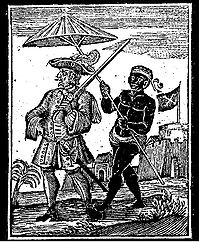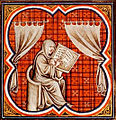Portal:Biography
The Biography Portal
A biography, or simply bio, is a detailed description of a person's life. It involves more than just basic facts like education, work, relationships, and death; it portrays a person's experience of these life events. Unlike a profile or curriculum vitae (résumé), a biography presents a subject's life story, highlighting various aspects of their life, including intimate details of experience, and may include an analysis of the subject's personality.
Biographical works are usually non-fiction, but fiction can also be used to portray a person's life. One in-depth form of biographical coverage is called legacy writing. Works in diverse media, from literature to film, form the genre known as biography.
An authorized biography is written with the permission, cooperation, and at times, participation of a subject or a subject's heirs. An autobiography is written by the person themselves, sometimes with the assistance of a collaborator or ghostwriter. (Full article...)
Featured biographies –
Arthur Oswin Austin (December 28, 1879 – June 7, 1964) was an American electrical engineer and inventor. He is the inventor of the Austin transformer, a double-ring toroidal transformer used to supply power for lighting circuits on radio towers. Austin's research included improvements to radio transmission equipment and the effects of lightning on high-voltage transmission lines and aircraft. He was a fellow of the American Institute of Electrical Engineers and of the Institute of Radio Engineers, and was an expert in high-voltage insulators and fittings. His work on transmitting antennas included both military and civilian projects.
A native of California, Austin graduated from Leland Stanford University with a degree in electrical engineering. He lived for a few years in New York, where he worked for General Electric and the Lima Insulator Company, but spent most of his adult life in Ohio where he married, worked for the Ohio Brass Company and founded the Austin Insulator Company. He bought a large estate in Barberton, Ohio, lived in the mansion, and built an extensive outdoor electrical laboratory on the grounds. (Full article...)
Lieutenant General Sir Edmund Francis Herring, KCMG, KBE, DSO, MC, KStJ, ED, KC (2 September 1892 – 5 January 1982) was a senior Australian Army officer during the Second World War, Lieutenant Governor of Victoria, and Chief Justice of the Supreme Court of Victoria. A Rhodes scholar, Herring was at New College, Oxford, when the First World War broke out and served with the Royal Field Artillery on the Macedonian front, for which he was awarded the Military Cross and Distinguished Service Order. After the war he carved out a successful career as a barrister and King's Counsel. He also joined the Australian Army, rising to the rank of colonel by 1939.
During the Second World War, Herring commanded the 6th Division Artillery in the Western Desert campaign and the Battle of Greece. In 1942, as a corps commander, he commanded the land forces in the Kokoda Track campaign. The following year, he directed operations in the Salamaua-Lae campaign and Finisterre Range campaign. Herring left his corps to become the longest-serving Chief Justice and Lieutenant Governor of Victoria, serving for three decades. In the latter capacity, he was patron of many charitable organisations. (Full article...)
Marcian (/ˈmɑːrʃən/; Latin: Marcianus; Greek: Μαρκιανός Markianos; c. 392 – 27 January 457) was Roman emperor of the East from 450 to 457. Very little of his life before becoming emperor is known, other than that he was a domesticus (personal assistant) who served under the commanders Ardabur and his son Aspar for fifteen years. After the death of Emperor Theodosius II on 28 July 450, Marcian was made a candidate for the throne by Aspar, who held much influence because of his military power. After a month of negotiations Pulcheria, Theodosius' sister, agreed to marry Marcian. Zeno, a military leader whose influence was similar to Aspar's, may have been involved in these negotiations, as he was given the high-ranking court title of patrician upon Marcian's accession. Marcian was elected and inaugurated on 25 August 450.
Marcian reversed many of the actions of Theodosius II in the Eastern Roman Empire's relationship with the Huns under Attila and in religious matters. Marcian almost immediately revoked all treaties with Attila, ending all subsidy payments to him. In 452, while Attila was raiding Roman Italy, then a part of the Western Roman Empire, Marcian launched expeditions across the Danube into the Great Hungarian Plain, defeating the Huns in their own heartland. This action, accompanied by the famine and plague that broke out in northern Italy, allowed the Western Roman Empire to bribe Attila into retreating from the Italian peninsula. (Full article...)

Pierre Louis Joseph Boulez (French: [pjɛʁ lwi ʒozεf bulɛz]; 26 March 1925 – 5 January 2016) was a French composer, conductor and writer, and the founder of several musical institutions. He was one of the dominant figures of post-war contemporary classical music.
Born in Montbrison, in the Loire department of France, the son of an engineer, Boulez studied at the Conservatoire de Paris with Olivier Messiaen, and privately with Andrée Vaurabourg and René Leibowitz. He began his professional career in the late 1940s as music director of the Renaud-Barrault theatre company in Paris. He was a leading figure in avant-garde music, playing an important role in the development of integral serialism in the 1950s, controlled chance music in the 1960s and the electronic transformation of instrumental music in real time from the 1970s onwards. His tendency to revise earlier compositions meant that his body of work was relatively small, but it included pieces considered landmarks of twentieth-century music, such as Le Marteau sans maître, Pli selon pli and Répons. His uncompromising commitment to modernism and the trenchant, polemical tone in which he expressed his views on music led some to criticise him as a dogmatist. (Full article...)

Colin Robert Chase (February 5, 1935 – October 13, 1984) was an American academic. An associate professor of English at the University of Toronto, he was known for his contributions to the studies of Old English and Anglo-Latin literature. His best-known work, The Dating of Beowulf, challenged the accepted orthodoxy of the dating of the Anglo-Saxon poem Beowulf—then thought to be from the latter half of the eighth century—and left behind what was described in A Beowulf Handbook as "a cautious and necessary incertitude".
Born in Denver, Chase was one of three sons of a newspaper executive and a Pulitzer Prize-winning playwright, Mary Coyle Chase. Chase's two brothers became actors; he considered such a career, but ultimately studied English literature, classics, and philosophy. He received his Bachelor of Arts from Harvard University, Master of Arts from Saint Louis and Johns Hopkins Universities, and Ph.D. from the University of Toronto in 1971, the same year the university named him an assistant professor. (Full article...)
Ulysses S. Grant (born Hiram Ulysses Grant; April 27, 1822 – July 23, 1885) was the 18th president of the United States, serving from 1869 to 1877. As commanding general, Grant led the Union Army to victory in the American Civil War in 1865.
Grant was born in Ohio and graduated from the United States Military Academy (West Point) in 1843. He served with distinction in the Mexican–American War, but resigned from the army in 1854 and returned to civilian life impoverished. In 1861, shortly after the Civil War began, Grant joined the Union Army and rose to prominence after securing victories in the western theater. In 1863, he led the Vicksburg campaign that gave Union forces control of the Mississippi River and dealt a major strategic blow to the Confederacy. President Abraham Lincoln promoted Grant to lieutenant general and command of all Union armies after his victory at Chattanooga. For thirteen months, Grant fought Robert E. Lee during the high-casualty Overland Campaign which ended with the capture of Lee's army at Appomattox, where he formally surrendered to Grant. In 1866, President Andrew Johnson promoted Grant to General of the Army. Later, Grant broke with Johnson over Reconstruction policies. A war hero, drawn in by his sense of duty, Grant was unanimously nominated by the Republican Party and then elected president in 1868. (Full article...)
Frédéric François Chopin (born Fryderyk Franciszek Chopin; 1 March 1810 – 17 October 1849) was a Polish composer and virtuoso pianist of the Romantic period, who wrote primarily for solo piano. He has maintained worldwide renown as a leading musician of his era, one whose "poetic genius was based on a professional technique that was without equal in his generation".
Chopin was born in Żelazowa Wola and grew up in Warsaw, which in 1815 became part of Congress Poland. A child prodigy, he completed his musical education and composed his earlier works in Warsaw before leaving Poland at the age of 20, less than a month before the outbreak of the November 1830 Uprising. At 21, he settled in Paris. Thereafter he gave only 30 public performances, preferring the more intimate atmosphere of the salon. He supported himself by selling his compositions and by giving piano lessons, for which he was in high demand. Chopin formed a friendship with Franz Liszt and was admired by many of his musical contemporaries, including Robert Schumann. After a failed engagement to Maria Wodzińska from 1836 to 1837, he maintained an often troubled relationship with the French writer Aurore Dupin (known by her pen name George Sand). A brief and unhappy visit to Mallorca with Sand in 1838–39 would prove one of his most productive periods of composition. In his final years, he was supported financially by his admirer Jane Stirling. For most of his life, Chopin was in poor health. He died in Paris in 1849 at the age of 39. (Full article...)
Edward Low (also spelled Lowe or Loe; c. 1690–1724) was a pirate of English origin during the latter days of the Golden Age of Piracy, in the early 18th century. Low was born into poverty in Westminster, London, and was a thief from an early age. He moved to Boston, Massachusetts, as a young man. His wife died in childbirth in late 1719. Two years later, he became a pirate, operating off the coasts of New England and the Azores, and in the Caribbean.
Low captained a number of ships, usually maintaining a small fleet of three or four. Low and his pirate crews captured at least a hundred ships during his short career, burning most of them. Although he was active for only three years, Low remains notorious as one of the most vicious pirates of the age, with a reputation for violently torturing his victims before murdering them. (Full article...)












![Image 2 George IV Artist: Sir Thomas Lawrence An oil on canvas portrait of George IV of the United Kingdom as the Prince Regent, by Sir Thomas Lawrence. In 1814, Lord Stewart, who had been appointed ambassador in Vienna and was a previous client of Thomas Lawrence, wanted to commission a portrait by him of the Prince Regent. He arranged that Lawrence should be presented to the Prince Regent at a levée. Soon after, the Prince visited Lawrence at his studio in Russell Square. Lawrence wrote to his brother that: To crown this honour, [he] engag'd to sit to me at one today and after a successful sitting of two hours, has just left me and comes again tomorrow and the next day. More selected portraits](http://upload.wikimedia.org/wikipedia/commons/thumb/9/9f/George_IV_bust1.jpg/84px-George_IV_bust1.jpg)


































